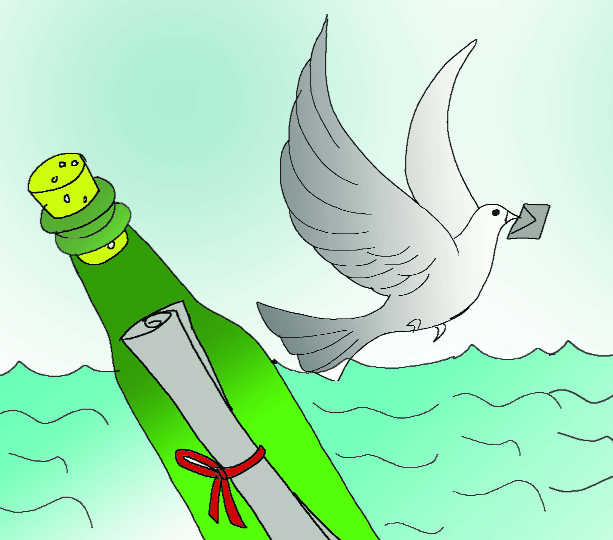
Illustration: Vishu Verma
Harvinder Khetal
The World’s Oldest Message In A Bottle Survived 132 Years. Now It’s Been Found.” I was wonderstruck as this headline caught my eye.
Human beings, being a social animal, are adept at communicating with one another. And being intelligent and inventive fellows, they are forever endeavouring to uncover and evolve cleverer ways of verbal and non-verbal transmissions, via the valuable levers of words, actions, objects, signs, scripts, messaging, technology. At times, you don’t even have to be verbose. Just a look can melt, or freeze, the onlooker. A mere movement of an eyebrow or a finger has the might of saying it all, leading to the moving of mountains and drawing of swords. Of course, that many a time we manage to majorly miss the message or misinterpret it only makes our manners and mannerisms monstrously merrier.
Like, for instance, the above-mentioned message sealed in the bottle that was tossed into the ocean over a century ago. The dark green bottle was found by Tonya Illman while she was walking on the beach in Perth, Australia. As the family tipped the sand out of the bottle that they thought would look good on their bookshelf, they discovered a damp note, rolled tightly and wrapped with string. On drying, the note was found to be a printed form, with very faint German handwriting on it. There were two significant details: the date June 12, 1886 and the name of a ship, “Paula.”
Sensing some historical significance, they took it to Western Australia Museum. Eventually, the bottle was found to be a part of a German Naval Observatory programme studying global ocean currents. A scientist, George von Neumayer, had implemented a drift bottle experiment from 1864 to 1933 that involved thousands of bottles being thrown overboard with pre-printed message slips inside. Ship captains were expected to write in details on one side of the paper and those who found the bottles were asked to fill out the back and return the notes.
Well, well! The slips of paper and bottles have today given way to computers and GPS tracking the ocean’s patterns today. The historic data of 19th century ships’ logbooks assumes importance, given the impending impact of climate change.
There are many other interesting precursors to today’s age of instant messaging and live-streaming. We all are familiar with pigeons passing on post. Our ancestors have been training pigeons to deliver mail for over three millennia as they realised that these birds had a wonderful sense of direction. Despite flying and foraging for hundreds of miles, they could without fail figure out their way back home. This gift of homing is due to their strong magnetoreception skills that enable them to detect and orient themselves on the basis of magnetic fields. Small rolls of parchment or paper were stored in a small glass or metal tube and sent through the birds. They proved to be better messengers than man, who could not be fully trusted with honesty. No wonder pigeons were preferred to postmen in politics, diplomacy and military, till World War II.
It reminds me of the game of Chinese Whispers. What happens when we pass a word from one ear to another? It’s hilarious how the original word gets distorted to something totally different as it gets misheard from one person to another. Imagine what would be the fate of a message if it is passed on through people! It is said that during World War I, a message was sent by word of mouth from one soldier to another from the trenches to British HQ. But what started as “Send reinforcements, we’re going to advance” became “Send three and fourpence, we’re going to a dance!”
And, the other most important point of conveying a point from one point to another is the maintenance of secrecy. It is here that the art of steganography comes into play. Steganography is the practice of concealing a file, message, image, or video within another file, message, image, or video. The word steganography is a portmanteau of the Greek words steganos (meaning covered, concealed, or protected) and graphein (meaning writing).
Johannes Trithemius first used the term in 1499 in his book ‘Steganographia’, a treatise on cryptography and steganography, disguised as a book on magic. Generally, the hidden messages appear to be (or be part of) something else: images, articles, shopping lists, or some other cover text.
We have heard of messages hidden in invisible ink between the visible lines of a letter. Or, as those grown up reading ‘mystery’ books are familiar with secret SOS messages being exchanged among spies and detectives using the Morse code or by tapping. In 1966, an American prisoner-of-war, Jeremiah Denton, repeatedly blinked his eyes in Morse code spelling out “T-O-R-T-U-R-E” during a televised press conference. This conveyed and confirmed to the Americans that the North Vietnamese were torturing American prisoners-of-war.
Instances of steganography are found ancient Greece (440 BC). There is a story by Herodotus that explains how a message was tattooed on the shaved scalp of a slave of Histiaeus. The message was then hidden as hair grew over it. And it was exposed to the receiver of by again shaving the head. The message allegedly carried a warning to Greece about Persian invasion plans. Ingenious! How can there not be women passing on steganotext? They used to secretly communicate through knitted codes. That is why new knitted patterns were banned during both wars!
Would our forefathers have imagined that by 2018, it would be a problem of too many messages flying thick and fast, fake and real, through the Internet, blocking phone memories? Though it’s good to be connected virtually, I wish we people don’t lose the personal touch. Guys, please mingle and spread mirth with messages.



























